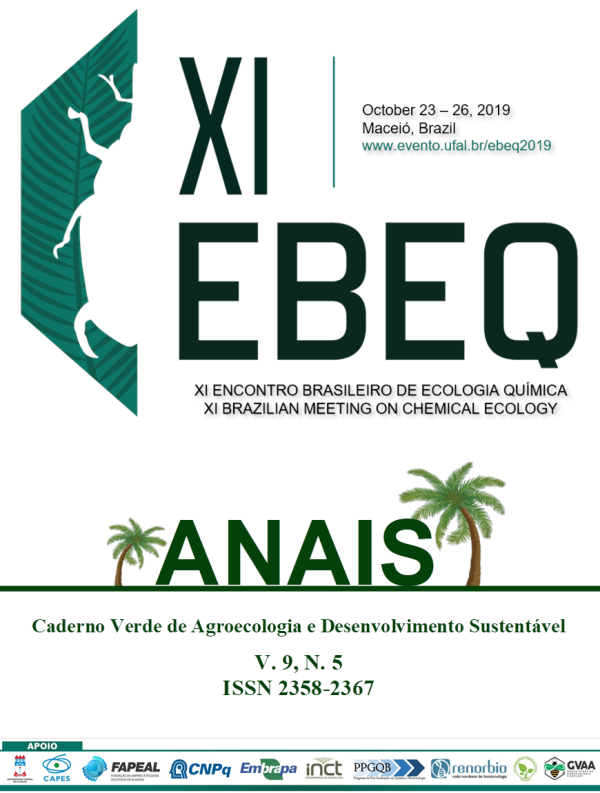IDENTIFICATION OF SEX PHEROMONE COMPOUNDS ATTRACTIVE TO Anthistarcha binocularis (LEPIDOPTERA: GELECHIIDAE) IN CASHEW
Palabras clave:
SEX PHEROMONE, CASHEW PEST, GELECHIIDAEResumen
The cashew stem borer Anthistarcha binocularis (Meyrick) is a major pest in cashew orchards in Brazil. The damage caused by the larvae results in economic losses, and the available chemical control is not suitable because of the endophytic nature of A. binocularis. The identification of the A. binocularis sex pheromone will allow the monitoring and mass collection control of this pest. To identify and confirm the attractiveness of the compounds, the following steps were followed: rearing of insects in the laboratory, observation of sexual behaviour, sexual gland extraction, attractiveness bioassays, electroantenography bioassay, analysis of spectra, characterization of compounds and confirmation by compound synthesis, and field attractiveness test. Two compounds from female sex gland extracts elicited electrophysiological responses on male antennae. They were identified as dodec-6-en-1-ol and dodec-6-en-1-yl acetate by gas chromatography-mass spectrometry. E/Z stereoisomers of both compounds were synthesized, and the electroantennograms for the synthetic compounds showed the strongest responses for the (E)-stereoisomers of the alcohol and acetate. In a field trial, the E6-12:OH/E6-12:OAc mixture attracted male A. binocularis, whereas the Z6-12:OH/Z6-12:OAc mixture attracted no specimens.The bioactive compounds from the sex pheromone of A. binocularis have been identified as a blend of two previously unidentified pheromone compounds: E6-12:OH and E6-12:OAc. The blend of compounds was attractive to males in preliminary field experiments, and this study is the first report of Δ6-unsaturated monoenyl pheromone compounds in Lepidoptera.Descargas
Publicado
Cómo citar
Número
Sección
Licencia
Termo de cessão de direitos autorias
Esta é uma revista de acesso livre, em que, utiliza o termo de cessão seguindo a lei nº 9.610/1998, que altera, atualiza e consolida a legislação sobre direitos autorais no Brasil.
O(s) autor(es) doravante designado(s) CEDENTE, por meio desta, publica a OBRA no Caderno Verde de Agroecologia e Desenvolvimento Sustentável, representada pelo Grupo Verde de Agroecologia e Abelhas (GVAA), estabelecida na Rua Vicente Alves da Silva, 101, Bairro Petrópolis, Cidade de Pombal, Paraíba, Brasil. Caixa Postal 54 CEP 58840-000 doravante designada CESSIONÁRIA, nas condições descritas a seguir:
O CEDENTE declara que é (são) autor(es) e titular(es) da propriedade dos direitos autorais da OBRA submetida.
O CEDENTE declara que a OBRA não infringe direitos autorais e/ou outros direitos de propriedade de terceiros, que a divulgação de imagens (caso as mesmas existam) foi autorizada e que assume integral responsabilidade moral e/ou patrimonial, pelo seu conteúdo, perante terceiros.
O CEDENTE mantêm os direitos autorais e concedem à revista o direito de divulgação da OBRA, com o trabalho simultaneamente licenciado sob a Licença Creative Commons do tipo atribuição CC-BY.
O CEDENTE têm autorização para distribuição não-exclusiva da versão do trabalho publicada nesta revista.
O CEDENTE têm permissão e são estimulados a publicar e distribuir seu trabalho online (ex.: em repositórios institucionais ou na sua página pessoal) a qualquer ponto antes ou durante o processo editorial, já que isso pode gerar alterações produtivas, bem como aumentar o impacto e a citação do trabalho publicado.










